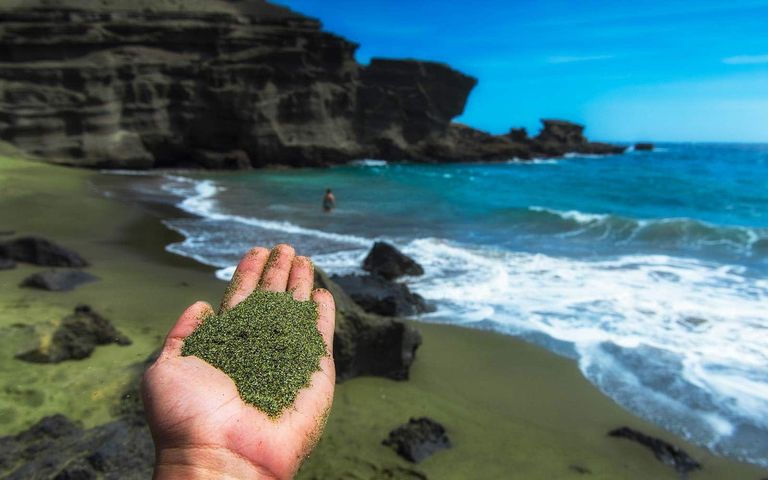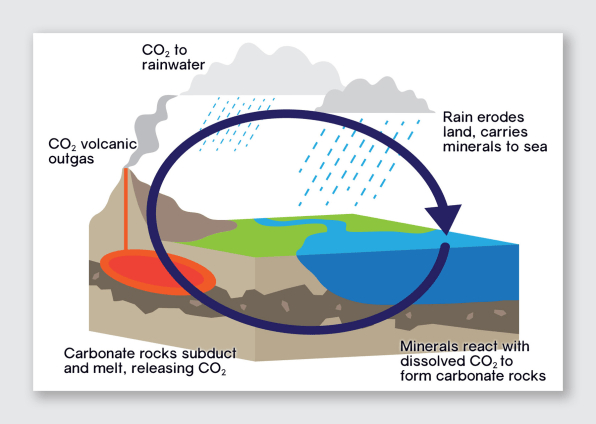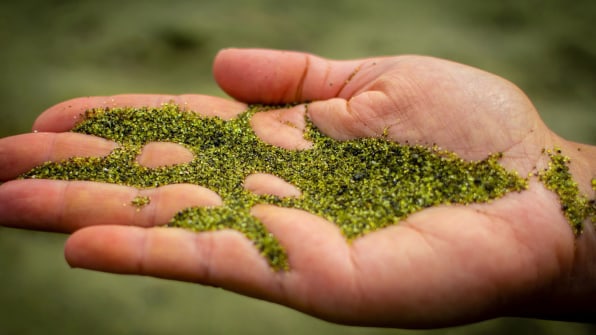
Project Vesta scientists believe their special green sand can slow climate change by removing carbon dioxide from the air on the beaches. What is this strange material and how can it be useful to the world? I am giving the details.
Idea
Company Project Vesta was founded in 2019 in San Francisco, on the basis of scientific center Climitigation . The goal of the startup was to create a technology that can effectively remove carbon dioxide from the atmosphere, since simply reducing CO₂ emissions is not very effective. The project participants knew that nature has a way of doing this that has been working for billions of years - with the help of volcanic rocks. When rain falls on these rocks and washes them into the ocean, a reaction occurs that pulls carbon dioxide out of the air and "hides" it in the limestone at the bottom of the ocean.
The idea of "carbonation", that is, the transfer of excess carbon dioxide into rocks and minerals, is itself a huge field for scientific research. "Why not develop this theme?" - thought at Project Vesta. And after numerous experiments, they settled on the use of olivine, crushed to a state of sand.
Olivine is a mineral of magmatic origin, widespread not only in the bowels of the earth's crust, but also in its mantle. On Earth, it is often found inside volcanic bombs, in the form of inclusions in basalt lava and in iron-stone meteorites. When a volcano is destroyed by the sea surf, beaches of green olivine sand are sometimes formed.
When the waves wash over the olivine, a small chemical reaction takes place - "weathering of the olivine", which pulls out some carbon dioxide, CO₂, from the air. A by-product of the reaction is bicarbonate HCO₃, which serves to reduce and regulate the acidity of both the human body and the ocean.

The bicarbonate is washed into the ocean, where marine organisms digest it and convert it into stable, solid calcium carbonate, of which their shells and skeletons are composed, as well as into coral structures. When corals and shellfish die, their remains sink to the ocean floor and form layers of limestone and similar rocks. Carbon remains locked up for millions or hundreds of millions of years until it is released again by volcanic activity. Since coccolithophores (plankton) are "carbon fixers" that remove carbon dioxide from the environment, scientists have proposed using them to tackle global emissions and climate change.
Project Vesta
This natural mechanism allows you to get rid of about half a billion tons of carbon dioxide per year. The problem is that society consistently produces more than 35 billion tons per year. So the main question is: is there a way to radically speed up and expand this process?
Numerous studies have theoretically proven that the process works, but until now no one has tried to do it on the beaches. “We studied all the material accumulated over 30 years of scientific research, including a lot of theoretical work and laboratory experiments ,” says Tom Green, executive director of Project Vesta.
After collecting all the information about the weathering of olivine and studying all the studies on CO₂ capture and other reactions that could help them in their work, scientists began work on a more effective way to combat climate change. They set themselves the goal of improving the technology created by nature, increasing its speed. And for this they decided to use crushed olivine, scattering it on the beaches.

The logic here is simple. Adding more HCO₃ can increase the production of harmless shells and other limestone and calcium elements. Grinding olivine into sand creates a large surface area to accelerate CO₂ absorption.
For objectivity's sake, I note that the idea of using CO₂ inference processes is not new. An article published 30 years ago suggests the use of silicatesto capture carbon dioxide. Five years later, Exxon researcher Harun Heshgi proposed using quicklime for the same purpose, and in the same year, Klaus Lackner, an expert in carbon removal , investigated many rock types in detail.
But these ideas were complex in themselves and were expensive in terms of price. And sand from olivine, according to Project Vesta's calculations, will be an order of magnitude more effective at low costs. Somewhere on the order of $ 10 per ton of carbon dioxide, if their technology is to be used on a large scale.
Project Vesta has unveiled plans for an experimental study in the Caribbean in the near future. This followed shortly after Stripe announced that it would pay the startup to remove 3,333 tons of carbon dioxide for $ 75 a tonne as part of its commitment to spend at least $ 1 million annually on emissions projects.
The work will be carried out on two beaches. During the study, one beach will be covered with olivine sand, and the second beach will be left in good condition as a control sample. The preliminary phase will also work with some of the scientific unknowns related to coastal areas with increased weathering.
The experiment will likely last a year or two. Ultimately, the team hopes to have data that demonstrates how fast and efficient this process is. The results obtained can be used to refine scientific models.
Problems and possible consequences

When studying a startup idea, a lot of questions arise. The most obvious one is: "When you mine, grind, ship and scatter huge amounts of olivine on the beaches, are you not producing more emissions than this mineral can pull out of the air?" Project Vesta says the benefits outweigh them. Research and laboratory simulations have shown that waves will significantly accelerate olivine degradation. And in one document it was concluded that the implementation of this project on 2% of the "most energetic shelf seas in the world" is able to compensate for all annual human emissions.
But the main problem is that the materials must be carefully polished so that the chemical processes go on for years, not decades. Some researchers have calculated that the resurfacing process is so costly and energy intensive that the entire approach seems unviable. However, others conclude that olivine sand will remove significantly more carbon dioxide than it will produce.
There is also a question about the final result of Project Vesta's work. It is difficult to predict whether the waves will help accelerate the CO₂ removal process, how well the absorption of carbon dioxide can be measured and tested, or how easily the public will accept the idea of scattering green minerals along the seashore.
Another area of concern to watch out for is potential environmental side effects. Minerals are actually a geological antacid, so they should reduce ocean acidification, at least at very local levels, which may benefit some sensitive coastal species. But olivine can also contain trace amounts of iron, silicate, and other materials that can stimulate the growth of some species of algae and phytoplankton, and otherwise alter ecosystems and food webs in ways that are difficult to predict.
Scientists are worried about the environmental problems that may arise as a result of the spread of the mineral on beaches where it was not before. Some critics believe that olivine can release heavy metals such as nickel. However, Project Vesta reassures skeptics that the nickel released into the water is not bioavailable, which means it should not affect marine species.
Competitors
The project has some advantages over other CO₂ removal approaches. First, the cost. Second, the main alternative, reforestation, does not necessarily lead to a decrease in carbon dioxide, as they often burn and trees are cut down. And in the case of Project Vesta, the ocean takes over the bulk of the work.
I also think it is necessary to mention other projects that are developing in the same direction. Researchers in Iceland channel a solution of carbon dioxide, captured by power plants or special machinery, into basalt formations deep underground, where volcanic rock coats it with stable carbonate minerals. Leverhulme Centerconducts field trials to assess whether basalt rock dust added to corn and soybean fields can act as a fertilizer and as a carbon dioxide scavenger.
And scientists from the University of British Columbia, along with colleagues from other universities in Canada and Australia, are exploring various uses for minerals extracted as a by-product of nickel, diamonds and platinum. The idea is to simply scatter them across the field, add water and slurry. They expect so-called mine tailings to quickly draw and mineralize carbon dioxide from the air, forming a solid block that can be buried. Their models show that this can eliminate the carbon footprint of mines.